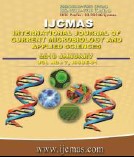


 National Academy of Agricultural Sciences (NAAS)
National Academy of Agricultural Sciences (NAAS)

|
PRINT ISSN : 2319-7692
Online ISSN : 2319-7706 Issues : 12 per year Publisher : Excellent Publishers Email : editorijcmas@gmail.com / submit@ijcmas.com Editor-in-chief: Dr.M.Prakash Index Copernicus ICV 2018: 95.39 NAAS RATING 2020: 5.38 |
Principal Component Analysis (PCA) is an important statistical tool through which we can easily access important polygenic characters which are of great importance in a plant breeding programme. The experiment was conducted with 35 germplasm accessions of brinjal to analyze genetic diversity at N. M. College of Agricultural, Navsari Agricultural University during the kharif season of 2016. The observations were recorded on sixteen different traits. PCA indicated that six components (PC-1 to PC-6) accounted for 70.73% of the total variation among traits in brinjal genotypes. Out of six principal components retained; PC-1, PC-2 and PC-3 explained 21.11%, 13.07% and 11.32% of the total variation respectively. The results of PCA indicated that traits like plant height (PH), leaf area per plant at 50 % flowering (LA), transpiration rate at 50 % flowering (TR), chlorophyll content at 50 % flowering (CC), number of fruits per plant (NF), fruit girth (FG), total phenol content (TPC) and total soluble sugar (TSS) could be used to distinguish the germplasms of brinjal in the heavy rainfall zone of South Gujarat. The result of present study could be utilized in planning and execution of future breeding strategies in brinjal.
 |
 |
 |
 |
 |